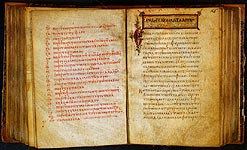Tetraevangelion. 9th cent.
O (142 ű 103). II+350 +I leaves. Several leaves are missing from divers parts of the codex.
Parchment. Ink, cinnabar, colours, gold.
A major text is written in slanting uncial; chapter numbers and chapter titles on the upper margins, references to the Eusebian Canons on the outer margins are in vertical uncial; liturgical instructions on the margins, the missing text supplied in the 12th century (?), the ends of the Gospel of Mark (fol. 162r) and the Gospel of John (350r) are in minuscule.
Each of 4 Gospels opens with a head-piece in the form of a gold panel preceding the biblical text (fols. 1r, 99r, 165r and 275r). There are also 4 ornamental initials of middle size in gold, red or black on the same folios and a one-colourŚ ornamental tail-pieces - a panel. Folio 177r bears the picture of bird .
The codex is an interesting example of book design of the Tetraevangelion (the Four Gospels) used for private worship, a very numerous type of manuscript, produced in Byzantine techniques, typical of the mid-ninth century.
The manuscript was given to Emperor Alexander II by Emmanuel Parodi, the nobleman from Smyrna (the city's modern Turkish name is Izmir) with the assistance of Constantin von Tischendorf, the noted German Biblical scholar. It entered the Imperial Public Library in 1859.
Shelfmark: –ÕŃ. √ūŚų. 34.





